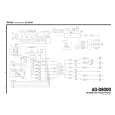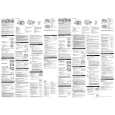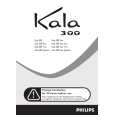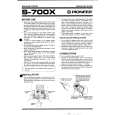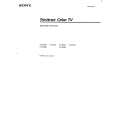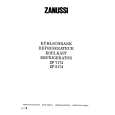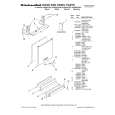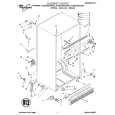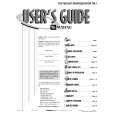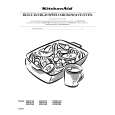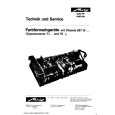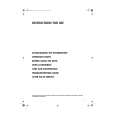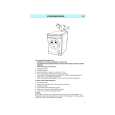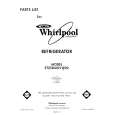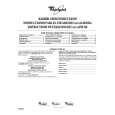|
|
|
Kategorie
|
|
Informacje
|
|
Polecamy
|
|
|
 |
|
|
Dla tego produktu nie napisano jeszcze recenzji!
 ;
Dokładna dokumentacja, pomogła w szybkiej naprawie telewizora. Dziękuję!
 ;
jedyne do czego mogę mieć zastrzeżenie to jakość zdjęć zawartych w przesłanej instrukcji serwisowej ponieważ są fatalnej jakości, praktycznie nieczytelne. tak poza tym jestem zadowolony to jest to czego szukałem.
 ;
Wszystko w porządku.
Instrukcja czytelna i kompletna.
Dziękuję.
all right!
thank you.
 ;
Bardzo dobra instrukcja. Zawiera wszystko co potrzeba, polecam!
 ;
Instrukcja jest OK. Schematy czytelne, opisane niektóre procedury.
Circuit Descriptions, List of Abbreviations, and IC Data Sheets
There is a current source inside the UOC at pin 102. This pumps energy in the capacitor connected to this pin producing a pure saw tooth. The vertical drive signals and the E/W correction signal are derived. Pin 108 is the East-West drive (or AVL), and it is a single ended current output. The correction for �horizontal width for changed EHT� from this pin is available by setting the HCO bit to �1�. The Phase-2 Compensation available at pin 113 gives frame correction for high beam currents. The phase compensation signal is used to correct the phase of the picture from the horizontal drive signal. Pin 63 is the SANDCASTLE output (contains all sync info) and also HORIZONTAL FLYBACK (HFB) input. Pin 97 is the EHT tracking/over-voltage protection pin. The HCO bit can switch on the tracking on EW. If the voltage at pin 97 exceeds 3.9 V, the over-voltage protection will be activated and the horizontal drive is switched �off� via a slow stop. 9.3.2 Horizontal Deflection There are several executions (depending on the CRT): � Sets with no East-West correction. The principle of the horizontal deflection is based on the quasi-diode modulation circuit. This horizontal deflection circuit supplies the deflection current and auxiliary voltages from the LOT. � Sets with East-West correction. The principle of the horizontal deflection is based on a diode modulator with east-west correction. This horizontal deflection circuit supplies the deflection current and auxiliary voltages from the LOT. � Sets with dynamic East-West correction. The principle of the horizontal deflection is based on a diode modulator with dynamic east-west correction for picture tubes with inner pincushion. This horizontal deflection circuit supplies the deflection current and auxiliary voltages from the LOT. Basic Principle During a scan period, either the Line Transistor or diode(s) conduct to ensure a constant voltage over the deflection coil (that results in a linear current). During the flyback period, the Line Transistor stops conducting, and the flyback capacitor(s) together with the inductance of the deflection coil creates oscillation. First Part of Scan Pin 62 of the UOC delivers the horizontal drive signal for the Line Output stage. This signal is a square pulse of line frequency. L5402 is the flyback drive transformer. This transformer de-couples the line output stage from the UOC. It has a direct polarization. The flyback drive circuit works with the start-up supply taken from +6V of the Aux supply (and subsequently taking from VlotAux+9V). When the H-drive is high, TS7404 conducts, and transformer L5402 starts to store energy. The base of the line transistor TS7405 is low and therefore blocks. The current in the deflection coil returns from diode D6404. Second Part of Scan When the H-drive is low, TS7404 does not conduct, and the energy that is stored in the transformer will transfer to the secondary, making the base of the Line Transistor high. Then the Line Transistor starts to conduct. The current in the deflection coil returns from the transistor in another direction. Flyback At the moment the H-drive becomes high, the base of the Line Transistor becomes low. Both the Line Transistor and the Flyback Diode will block. There is an oscillation between the flyback capacitor C2412 and the deflection coil. Because of the inductance of the LOT, the Line Transistor cannot stop
L04E AA
9.
EN 75
conducting immediately. After the Line Transistor is out of conduction, the flyback pulse is created. The flyback capacitor charges until the current in the deflection coil reduce to zero. Then it discharges through the deflection coil and the deflection current increases from the other direction. The flyback diode conducts and is back to the first part of the scan. Linearity Correction Because the deflection coil has a certain resistance, a picture without any linearity issues cannot be expected. L5401 is the linearity coil to compensate for this resistance. It is a coil with a pre-magnetized core. This correction is called linearity correction. Horizontal S-Correction Because the electronic beam needs to travel a longer distance to both sides of the screen than the center, the middle of the screen would become narrower than both sides. To prevent this, a parabolic voltage is applied across the deflection coil during scan. To create this parabolic voltage, a capacitor called S-cap (C2417/C2418) is used as a voltage source during scan. The sawtooth current of the deflection through this capacitor creates the required parabolic voltage. This correction is called S-Correction. Mannheim-Circuit When the EHT is heavily loaded with a bright line, the flyback time can be increased a bit in this situation. As a result, the scan delays a bit causing a DC-shift to the right in the next line, which would create a small spike on the S-cap. This spike oscillates with the inductance of the deflection coil and the primary of LOT. The result is visible in vertical lines under horizontal white line. This is called the Mannheim-effect. To prevent this from happening, a circuit called Mannheimcircuit is added. This consists of C2415, R3404, R3417 and D6406. During the scan, C2415 is charged via R3417. During the flyback, the S-correction parabola across the S-Cap C2417/C2418 is in its most negative, and D6406 conducts. Thus, C2415 is switched in parallel to C2417/C2418 during flyback. As C2415 is much larger than C2417/C2418, the voltage across C2415 reduces the Mannheim-effect oscillation. Class D East-West Driver To reduce the power loss of the normal used linear East-West amplifier, a class-D East-West circuit is used. To achieve this, the East-West parabola waveform EW_DRIVE from the Hercules (frame frequency) is sampled with a saw tooth (line frequency) taken from the line aux output. Then a series of width-modulated pulses is formed via two inverted phase amplifiers, filtered by an inductor, which then directly drive the diode modulated line circuit. East-West Correction To achieve a good geometry, dynamic S-correction is needed. The design is such that the tube/yoke needs East-West correction. Besides that, an inner pincushion is present after East-West correction. The line deflection is modulated with a parabolic voltage (frame frequency). In this way it is not so much at top and bottom, and much more in the middle. Upon entering the picture geometry menu in the SAM mode, the following corrections will be displayed. � EWW: East West Width. � EWP: East West Parabola. � UCP: Upper Corner Parabola. � LCP: Lower Corner Parabola. � EWT: East West Trapezium. The East-West drive circuit realizes them all. The settings can be changed by a remote control. All changed data will be stored into the NVM after the geometry alignment.
|
|
 |
> |
|
